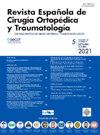通过X光平片和超声波对肩部钙化性肌腱病进行分类的观察者间可靠性。
Q3 Medicine
Revista Espanola de Cirugia Ortopedica y Traumatologia
Pub Date : 2025-05-01
DOI:10.1016/j.recot.2023.12.002
引用次数: 0
摘要
导言肩部钙化性肌腱病是肩部疼痛的常见原因。诊断通常基于超声波(US)和/或 X 光片。US 被认为是一种固有的依赖于操作者的成像模式,肌肉骨骼 US 方面的专家曾描述过观察者之间的差异性。本研究的主要目的是评估肩部钙化性肌腱病的观察者之间的一致性,即受过培训的肌肉骨骼放射科医生在平片和超声中分析的钙的大小、类型和位置:2018年6月至2019年5月,我们进行了一项前瞻性研究。纳入了被诊断为与钙化性肌腱病相关的肩痛患者。由两名不同的经验丰富的肌肉骨骼放射科医生独立评估平片和美片:结果:共纳入 40 名患者,平均年龄为 54.6 岁。平片和X光片上钙化类型的科恩卡帕系数(Cohen´s kappa coefficient)分别为 0.721 和 0.761。钙化位置在普通胶片和 US 中的系数分别为 0.927 和 0.760。钙化大小的类内相关系数(ICC)在平片和 US 中分别为 0.891 和 0.86。这两项测量结果均未发现有统计学意义的差异:这项研究表明,经验丰富的肌肉骨骼放射科医生对肩部钙化性腱鞘炎的类型和大小测量(平片和 US)的观察者间可靠性非常高:证据级别:III,前瞻性观察者间研究。本文章由计算机程序翻译,如有差异,请以英文原文为准。
Interobserver reliability of classifying shoulder calcific tendinopathy on plain radiography and ultrasound
Introduction
Shoulder calcific tendinopathy is a frequent cause of shoulder pain. Diagnosis is usually based on ultrasound (US) and/or X-ray. US is considered an inherently operator-dependent imaging modality and, interobserver variability has previously been described by experts in the musculoskeletal US. The main objective of this study is to assess the interobserver agreement for shoulder calcific tendinopathy attending to the size, type, and location of calcium analyzed in plain film and ultrasound among trained musculoskeletal radiologists.
Material and methods
From June 2018 to May 2019, we conducted a prospective study. Patients diagnosed with shoulder pain related to calcific tendinopathy were included. Two different experienced musculoskeletal radiologists evaluated independently the plain film and the US.
Results
Forty patients, with a mean age of 54.6 years, were included. Cohen's kappa coefficient of 0.721 and 0.761 was obtained for the type of calcium encountered in plain film and the US, respectively. The location of calcification obtained a coefficient of 0.927 and 0.760 in plain film and US, respectively. The size of the calcification presented an intraclass correlation coefficient (ICC) of 0.891 and 0.86 in plain film and US respectively. No statistically significant differences were found in either measurement.
Conclusion
This study shows very good interobserver reliability of type and size measurement (plain film and US) of shoulder calcifying tendinopathy in experienced musculoskeletal radiologists.
求助全文
通过发布文献求助,成功后即可免费获取论文全文。
去求助
来源期刊

Revista Espanola de Cirugia Ortopedica y Traumatologia
Medicine-Surgery
CiteScore
1.10
自引率
0.00%
发文量
156
审稿时长
51 weeks
期刊介绍:
Es una magnífica revista para acceder a los mejores artículos de investigación en la especialidad y los casos clínicos de mayor interés. Además, es la Publicación Oficial de la Sociedad, y está incluida en prestigiosos índices de referencia en medicina.
 求助内容:
求助内容: 应助结果提醒方式:
应助结果提醒方式:


